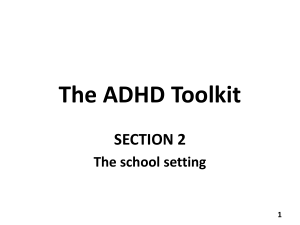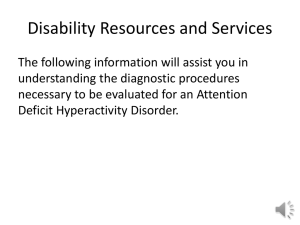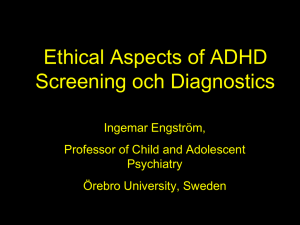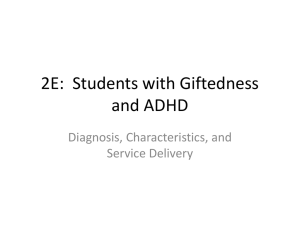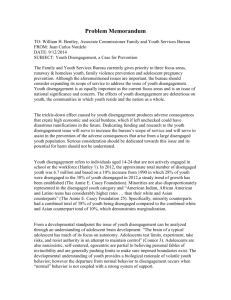ATTENTION - Neuropsychology CHILD Foundation
advertisement
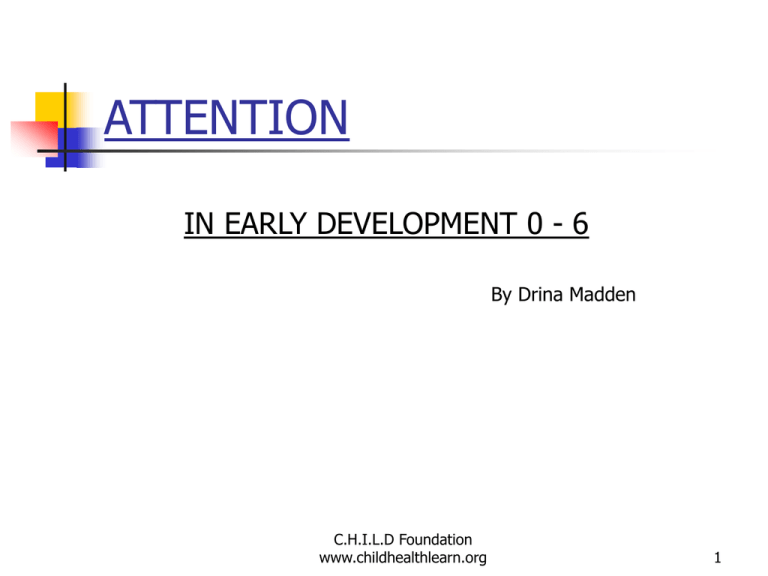
ATTENTION IN EARLY DEVELOPMENT 0 - 6 By Drina Madden C.H.I.L.D Foundation www.childhealthlearn.org 1 Introduction Attention is essential for perception and learning C.H.I.L.D Foundation www.childhealthlearn.org 2 Introduction Effective attention requires interplay of: Intense concentration Inhibition of distractibility Ability to shift awareness from one focus to another C.H.I.L.D Foundation www.childhealthlearn.org 3 Characteristics of Normal 0-3 Attention Development 1 – 2 months Engage and focus When awake, look around Focus on big and bright Can’t shift focus C.H.I.L.D Foundation www.childhealthlearn.org 4 0-3 Attention Development 2 – 3 months Major developmental transition Notice smaller discrepancies Recognize mother at 6 – 9 weeks C.H.I.L.D Foundation www.childhealthlearn.org 5 0-3 Attention Development 2 – 3 months Major developmental transition Visual acuity increases Visual orienting is coordinated with attention Mutual face to face attention with adults C.H.I.L.D Foundation www.childhealthlearn.org 6 0-3 Attention Development 2 – 3 months When awake, look around Focus on big and bright Can’t shift focus C.H.I.L.D Foundation www.childhealthlearn.org 7 0-3 Attention Development 4 months Can control the shift of attention More flexible attention C.H.I.L.D Foundation www.childhealthlearn.org 8 0-3 Attention Development 3 – 9 months Visual attention is influenced by the novelty of events/objects Visual acuity and binocular vision reach adult levels by 6 to 7 months C.H.I.L.D Foundation www.childhealthlearn.org 9 0-3 Attention Development 3 – 9 months The “where” system is in place (parietal) Then the “what” system is complete – ability to recognize objects (temporal) Has difficulty remembering and inhibiting actions C.H.I.L.D Foundation www.childhealthlearn.org 10 0-3 Attention Development 9 – 12 months Begin to reach and grasp toward an inanimate object Begin to imitate the action of others – after a delay Begin to anticipate the future based on the past Means to end processing begins C.H.I.L.D Foundation www.childhealthlearn.org 11 0-3 Attention Development 9 – 12 months Duration of looking decreases due to: An increase of learning speed Development of memory Can control actions C.H.I.L.D Foundation www.childhealthlearn.org 12 0-3 Attention Development 9 – 12 months Social referencing begins. Can attend to mother when she is far away Fear of strangers begins (memory is up) C.H.I.L.D Foundation www.childhealthlearn.org 13 0-3 Attention Development 9 – 12 months Motor skills are emerging Crawling begins which alters the child’s perspective and brings new aspects of physical and social awareness C.H.I.L.D Foundation www.childhealthlearn.org 14 0-3 Attention Development 9 – 12 months (cont.) Behavior is more flexible and coordinated Can share attention with adults and toys Beginning of higher level attention (executive control) C.H.I.L.D Foundation www.childhealthlearn.org 15 0-3 Attention Development 1st year Orient to new, important events for the purpose of exploring and learning Spatial orienting and questioning system becomes functional and controls the first year of attention Becomes aware of locations and objects in the environment (temporal + parietal) C.H.I.L.D Foundation www.childhealthlearn.org 16 0-3 Attention Development End of first year Ability to plan goal directed activity increases – dependent upon social input(frontal lobe begins) Underpinnings of new, controlled attention system begins Can follow directions Can focus on objects and adults C.H.I.L.D Foundation www.childhealthlearn.org 17 0-3 Attention Development 18 months Can coordinate attention with toys and partners in play Language assists in developing Information Values Directions Attention to the action of others leads to: Social expectations standards – examples of attitude and strategies C.H.I.L.D Foundation www.childhealthlearn.org 18 0-3 Attention Development 18 months plus Differences in development may reflect Speed of learning Amount of information acquired Temperament Emotional tone C.H.I.L.D Foundation www.childhealthlearn.org 19 0-3 Attention Development 18 months plus Inhibitory control Low stimulation may cause impulsivity, sensation seeking or responsiveness to rewards May be due to variations in the Neurotransmitter system C.H.I.L.D Foundation www.childhealthlearn.org 20 0-3 Attention Development Toddler = new attention system Attention to novelty decreases Attention to what others attend to increases More related to planned, self-generated activity Exploration is decreased, looking is increased Plans powerfully organize behavior C.H.I.L.D Foundation www.childhealthlearn.org 21 0-3 Attention Development Toddlers (18mos +) Language spurts and accompanies action Symbolic functioning is ,thus, able to begin C.H.I.L.D Foundation www.childhealthlearn.org 22 0-3 Attention Development Toddlers (18mos +) Knowledge can now be based on generalized and abstract knowledge rather than mere perception and action Eventually, language DIRECTS action Can act on verbal instructions C.H.I.L.D Foundation www.childhealthlearn.org 23 0-3 Attention Development Toddlers (18mos +) Begin to identify themselves in a mirror New sense of self New level of self-regulation Recognize that they have an effect on the environment Take pleasure in producing particular outcomes for themselves C.H.I.L.D Foundation www.childhealthlearn.org 24 0-3 Attention Development Toddler (cont) Plans powerfully organize behavior Attention increases to carry out activity and complete plans C.H.I.L.D Foundation www.childhealthlearn.org 25 0-3 Attention Development Toddler (cont) Squirming decreases Walking away from assigned tasks decreases Awareness of noise increases C.H.I.L.D Foundation www.childhealthlearn.org 26 0-3 Attention Development Toddlers (cont) Interest level affects attention Memory deployment becomes systematic C.H.I.L.D Foundation www.childhealthlearn.org 27 0-3 Attention Development Toddlers (cont) Self-regulation begins to change behavior based on cognitive, social and emotional demands Interplay begins – the ability to share attention with others C.H.I.L.D Foundation www.childhealthlearn.org 28 0-6 Attention Development Preschool Continuation of higher brain controls Self-monitoring Control over impulsive responses Problem solving increases Memory increases C.H.I.L.D Foundation www.childhealthlearn.org 29 0-6 Attention Development Preschoolers Development reflects higher level brain functions Consolidation of skills Gradual accumulation of knowledge Improved ability to plan Increased ability to sit Enhanced self-control C.H.I.L.D Foundation www.childhealthlearn.org 30 Stages of Attention Initiation (starting) Cortex of the brain must be aroused Orienting response is alerted when an event captures our attention Meet a new or exciting event Brain is alerted Prepares to learn more about the event C.H.I.L.D Foundation www.childhealthlearn.org 31 Stages of Attention Initiation Orienting response is relatively automatic Responds to moderately intense changes in stimulation Responds to relatively complex stimuli more quickly than simple ones Signal the possibility of interesting events C.H.I.L.D Foundation www.childhealthlearn.org 32 Stages of Attention Initiation Once the second level of attention develops, a child may CHOOSE to work on a task Attention by choice responds more slowly than the “orienting response” C.H.I.L.D Foundation www.childhealthlearn.org 33 Stages of Attention Engagement Physical changes signaling increased attention Facial expression of interest Raised or knit eyebrows and slightly open mouth Lower lip rolled under or tongue protruding Interest/excitement incr. During exploration Joy incr. During play C.H.I.L.D Foundation www.childhealthlearn.org 34 Stages of Attention Engagement Physical changes signaling increased attention Motor activity Activity and movement-related inattention decline during preschool years Physically moving away decr. between 2.5 and 3.5 years Frequency of small movements decr. Significantly between 3 and 7 years Movement competes with sustained attention C.H.I.L.D Foundation www.childhealthlearn.org 35 Stages of Attention Engagement Physical changes signaling increased attention Decrease in heart rate and variability Integration of response systems Developments in the engagement of attention are dependent, in part on the developing integration of the facial, motor and heart rate responses C.H.I.L.D Foundation www.childhealthlearn.org 36 Stages of Attention Disengagement and Termination of Attention Once engaged, an active process of disengagement is necessary to shift attention to another object of location C.H.I.L.D Foundation www.childhealthlearn.org 37 Stages of Attention Disengagement Disengagement begins to occur at around 4 months Maturation of neural mechanisms Expansion of the visual field Faster attention ability Repetition follows more focused initial attention C.H.I.L.D Foundation www.childhealthlearn.org 38 Stages of Attention Disengagement Top-down (second attention system) attention allows a child to engage and disengage on instruction or decision to do so C.H.I.L.D Foundation www.childhealthlearn.org 39 Stages of Attention Distractiblility at all ages will be determined by: interplay of the child’s motivation and internal state nature of the distractors nature of the child’s activity C.H.I.L.D Foundation www.childhealthlearn.org 40 Early Signs of ADHD Physical Anomalies – more anomalies = more aggression and less attention Biological markers related to preschool behaviors Malformed ears Missing creases on palm Brain chemical/electrical variations Brain formation variations C.H.I.L.D Foundation www.childhealthlearn.org 41 Early Signs of ADHD Spent less time playing Engaged in more functional play Acted younger than their peers Less construction and dramatic play Less time playing beside or with other children Less likely to converse with other children C.H.I.L.D Foundation www.childhealthlearn.org 42 Early Signs of ADHD More negative interactions with adults Difficulties increase when need to sit still More impulsivity Behavior reported as being more problematic by their parents Differences continued in a three year study C.H.I.L.D Foundation www.childhealthlearn.org 43 Early Signs of ADHD Developmental patterns of ADHD 3 year old ratings More restless More disobedient Less concentration than others More behavior problems More destructive Less popular with peers C.H.I.L.D Foundation www.childhealthlearn.org 44 Early Signs of ADHD Developmental patterns of ADHD 4 year olds Same as threes but had fewer problems with disobedience than threes. 6 year olds indicated an increase in concentration but other symptoms remained – especially restlessness C.H.I.L.D Foundation www.childhealthlearn.org 45 Early signs of ADD w/o H Low attenders Less adaptable Less likely to approach new objects and situations More negative mood Less sensitive or responsive to sounds and sights C.H.I.L.D Foundation www.childhealthlearn.org 46 ADD in other conditions Regulatory disorders that continue past 6 months Disturbances in sleep Difficulties in consoling self Difficulties around feeding Hyperarousal (disorganization and distractibility in the face of new stimulation) C.H.I.L.D Foundation www.childhealthlearn.org 47 ADD in other conditions Regulatory disorders that continue past 6 months Difficulty regulating the state necessary for sustained and focused attention Cannot inhibit their own body concerns to be able to attend May have difficulties behaviorally engaging with their environment C.H.I.L.D Foundation www.childhealthlearn.org 48 ADD in Autism Attention to Toys Less manipulatives than the norms Autistic children attended to and manipulated more simple toys Attention to Environment Less attentive to adults’ points, shifts in gaze, and displays of objects C.H.I.L.D Foundation www.childhealthlearn.org 49 ADD in Autism Communication Less likely to communicate with gesture Less likely to look from toy to adult Less likely to display positive emotion Facial expressions tend to be neutral Decreased joint attention C.H.I.L.D Foundation www.childhealthlearn.org 50 ADD in Autism Social attention Difficulty in attending to the complexity and unpredictability of social events Easily become overstimulated Need social situations to be simplified and more predictable to attend C.H.I.L.D Foundation www.childhealthlearn.org 51 Summary Attention deficits are due to a breakdown in the ability to Initiate Engage Sustain And/Or Shift attention C.H.I.L.D Foundation www.childhealthlearn.org 52 Summary They have a biological, neurological base: Metabolic Electrical They can be predicted by behaviors in preschool Early inattention interferes with top-down, selfregulating attention development C.H.I.L.D Foundation www.childhealthlearn.org 53





